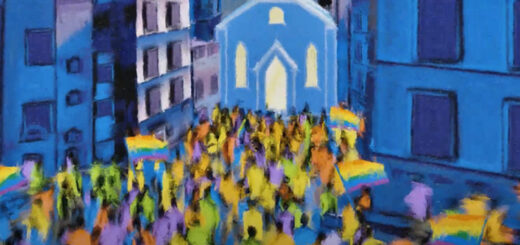The pilgrimage of the transsexuals (femminielli) to the Black Madonna of Montevergine (Italy)
Article by Laura Filios, published in the Jesuit Catholic monthly JESUS (Italy), n.6 of June 2020, pp.52-55, translated by Andrea D. (La Tenda di Gionata)
Every year thousands of devotees visit the shrine of Montevergine in the Italian region of Campania (Italy). Among them, many transsexuals who feel welcome in front of “Mamma Schiavona” (Slave Mama or Slavic Mama). “Even if we are daughters of an ancient cultural tradition, discrimination against us is still deeply rooted.”
At the beginning of February, coronavirus in Italy was not yet a death-dealing affair. But Loredana Rossi prayed Mamma Schiavona for the grace – “lu miracolo” – “that only she would wear the crown: that she would make this virus disappear and that she would restore serenity to everyone“. As if she felt that things would soon get out of hand.
In the Catholic world, 2nd February marks Candlemas Day. During the rite of purification, candles are blessed and symbolize Christ who is “light to enlighten the people“, as Jesus is defined in the episode of the Presentation at the Temple. For the faithful from Campania, this date also coincides with the pilgrimage to the sanctuary of Montevergine.
Thousands of devotees of the Black Madonna from all over the region dance and sing their way to the top of Mount Partenio, located in the province of Avellino. Among them there are also transsexuals or “femminielli“, considered almost mythological figures in Neapolitan popular culture, who in Montevergine celebrate the famous juta (the ascent) to pay homage to Mamma Schiavona “who grants everything and forgives everything”.
On Sunday morning, Naples is a ghost town. No traffic jams, few passersby, the noise muffled by the sea. The pink light of dawn that lights the alleys bathes the buildings and softens the edges. The meeting is at 8 am, in a side street of Piazza Garibaldi, near the Central station. One of the persons who punctually waits for the others is Loredana, one of the founders of the 15-year old ‘Naples Transsexual Association’.
Curly blond hair, a bursting voice just like her lips. Alongside her there is Ileana Capurro, the current president. While they welcome each other with hugs and kisses, they do a head count. When the bus arrives, the group gets bigger: apart from the devotees, there are also a Danish TV director, a couple of French tourists and a few journalists.
There is a lot of curiosity and devotion. They wait for the latecomers. It takes a little more than an hour to get to Mercogliano “but there will be a lot of traffic”. The shrine is situated on top of the mountain, at 1400 meters above sea level. The cult of the Black Madonna at Montevergine is linked to Guglielmo da Vercelli.
The Madonna has a brown face and is painted on a large wooden altarpiece hoisted in a small chapel within the monumental complex. In fact, schiavo in Neapolitan dialect means “dark skin”. Hence its middle name. Over time, Mamma Schiavona become a sort of an icon ante litteram for the LGBT world. The reason is related to a legend dating back to 1256. It is said that two boys, spotted cuddling and kissing, were tied to a tree on Mount Parthenus, in the cold and without food.
They sought to make them die of starvation. Panic-stricken and in the face of certain death, the two prayed to the Madonna for her intervention. She arrived, wrapped them in her cloak and saved them. The miracle was seen as a sign of supernatural tolerance and since then the femminielli became fervent devotees of the Black Madonna of Montevergine.
Marzia Mauriello is an anthropologist who has been studying the phenomenon for over ten years. She is on the bus too. Her voice can be hardly heard among the hymns to the Madonna and the loud songs from the national-popular repertoire. She is speaking with one of the French persons who is an actor: “The femminiello is a very ancient figure. The first written records date back to the end of the 1500s when Giovan Battista della Porta spoke about it. At the time they called them” effeminate men “The word “femminiello” seems to have spread around the second half of the 1900s. They are difficult figures to place. They could be defined as transsexual subjects – the term transgender was coined in the 1970s and has achieved notoriety in the 1990s – but there are also those who consider them a third gender in their own right”.
The top of the mountain is immersed in the fog which becomes denser and milkier at each bend. At the twelfth and last bend, a ray of sunshine appears. There is usually snow here in February but oddly not this year. The euphoria can be felt from the parking lot. Pilgrims crowd the roadside and the sound of drum-based singing is incessant. There is a large crowd. In some places, it is quite difficult to move and get around. Ileana gets off the bus and announces the schedule for the day. After mass and tribute to the Madonna, the programme includes lunch in an agritourism facility and the “licentious tombola”. “It is a day of celebration. It is the day in which everyone is equal in the eyes of the Madonna”.
“I’ve been coming here for 30 years now“, explains Loredana. “However, for the past 10 years, we have been organizing the pilgrimage to the sanctuary for transsexual girls through the Naples Transsexual Association. It is important to come because she is the Madonna who opens her arms to welcome us. In a world full of hate, the message of this Madonna is sacred to us“.
When Ileana approached the association as a professional, that is as a lawyer, she had no idea. “I couldn’t even imagine how difficult it was to overcome the stigma. It is not only rooted in workplaces but in everything you do. Even looking for a house can be a challenge. Just because you manifest yourself as a transsexual person, the idea is that you are doing forbidden things.”
Marzia agrees: “Today, even if being feminine in Naples means belonging to a very strong cultural tradition, this does not protect them from other forms of discrimination. They are often marginalized in daily life but at Montevergine they regain a sense of normalcy and feel accepted. The figure of the Black Madonna protects them and legitimizes their existence and presence at the sanctuary. A ritual like that of today is certainly a means to promote social inclusion“.
After all, a law against the crime of homophobia in our country has been due for more than 20 years. Before Italy was seriously affected by the Covid-19 pandemic, a draft bill “on violence or discrimination on grounds of sexual orientation or gender identity” was presented to the Justice Committee in October 2019.
The first signer was Alessandro Zan, a 46-year old from Padua who is serving his second legislative term under the banner of the Democratic Party. In January 2020, the Justice Commission merged together the several bills against homophobia and transphobia presented to the Chamber of Deputies. The intent was to draw up an effective law in the shortest time possible.
After the silent blessing of the candles, the typical folkloristic groups of the region break the silence in the chapel of the Black Madonna and, upon the singing of Ooo Madonna, lead the faithful in a moment of choral and liberating devotion. Stefania is among the youngest in the group and is the organizer of Miss Trans. As a child, when she still did not know exactly who she was, she always visited the sanctuary with her parents.
However, for the past 10 years she has been doing the pilgrimage with her friends and friends from the ‘Naples Transsexual Association’. “We all gather together and for me 2nd February is like Christmas. It is a worldwide party for the LGBT community and in particular for us transsexual girls because Mamma Schiavona is the mother of all but she is particularly the mother of the femminielli. We can say that 2nd February marks for us the feast of the femminielli”.
Who knows if Pope Francis is aware of this celebration? He is certainly present as shown by his recent gesture in support of transsexuals last April when he sent help to a transsexual group in Torvaianica (Rome) through the Papal Almoner Cardinal Konrad Krajewski.
Upon hearing the story, Loredana said enthusiastically: “You saw what Bergoglio did? To my memory, I never saw such a thing happen. This Pope has restored my hope in the Church. He has always helped those on the margins of society and now also the transsexuals, invisible among the invisible. With his donation he has shifted attention back to the marginalization which we transsexuals suffer on a daily basis“.
Original text> La juta dei Femminielli (PDF)






